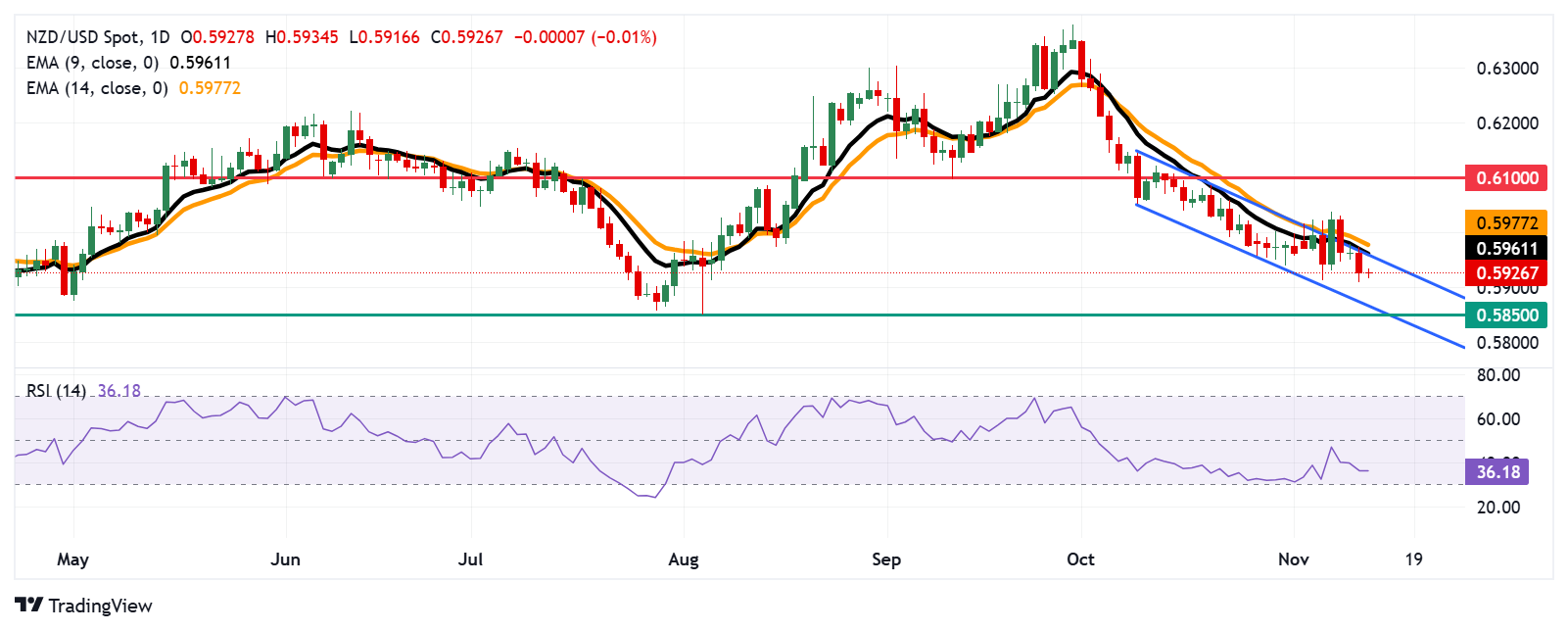- Аналітика
- Новини та інструменти
- Новини ринків
- NZD/USD Price Forecast: Remains below 0.5950, resistance appears at nine-day EMA
NZD/USD Price Forecast: Remains below 0.5950, resistance appears at nine-day EMA
- NZD/USD may test the upper boundary of the descending channel near the nine-day EMA at 0.5961 level.
- The nine-day EMA staying below the 14-day EMA indicates persistent weakness in short-term price momentum.
- The pair may navigate the area around the lower boundary of the descending channel at 0.5860 level.
The NZD/USD pair holds ground after registering losses in the previous session, trading around 0.5920 during European hours on Wednesday. The daily chart analysis shows a strong bearish trend, with the NZD/USD pair moving downwards within a descending channel.
The nine-day Exponential Moving Average (EMA) remains below the 14-day EMA, indicating continued weakness in short-term price momentum. Additionally, the 14-day Relative Strength Index (RSI), a key momentum indicator, is below the 50 mark, reflecting sustained bearish momentum. A further decline toward the 30 level would amplify this downward trend for the NZD/USD pair.
On the downside, the NZD/USD pair may find support around the psychological level of 0.5900. A break below this level could increase selling pressure, pushing the pair toward the lower boundary of the descending channel at 0.5860, with further throwback support at the psychological level of 0.5850.
In terms of resistance, the pair faces an immediate hurdle at the upper boundary of the descending channel near the nine-day EMA at 0.5961, followed by the 14-day EMA at 0.5977. A break above the 14-day EMA would strengthen price momentum, potentially enabling the NZD/USD pair to approach the psychological level of 0.6100.
NZD/USD: Daily Chart
New Zealand Dollar FAQs
The New Zealand Dollar (NZD), also known as the Kiwi, is a well-known traded currency among investors. Its value is broadly determined by the health of the New Zealand economy and the country’s central bank policy. Still, there are some unique particularities that also can make NZD move. The performance of the Chinese economy tends to move the Kiwi because China is New Zealand’s biggest trading partner. Bad news for the Chinese economy likely means less New Zealand exports to the country, hitting the economy and thus its currency. Another factor moving NZD is dairy prices as the dairy industry is New Zealand’s main export. High dairy prices boost export income, contributing positively to the economy and thus to the NZD.
The Reserve Bank of New Zealand (RBNZ) aims to achieve and maintain an inflation rate between 1% and 3% over the medium term, with a focus to keep it near the 2% mid-point. To this end, the bank sets an appropriate level of interest rates. When inflation is too high, the RBNZ will increase interest rates to cool the economy, but the move will also make bond yields higher, increasing investors’ appeal to invest in the country and thus boosting NZD. On the contrary, lower interest rates tend to weaken NZD. The so-called rate differential, or how rates in New Zealand are or are expected to be compared to the ones set by the US Federal Reserve, can also play a key role in moving the NZD/USD pair.
Macroeconomic data releases in New Zealand are key to assess the state of the economy and can impact the New Zealand Dollar’s (NZD) valuation. A strong economy, based on high economic growth, low unemployment and high confidence is good for NZD. High economic growth attracts foreign investment and may encourage the Reserve Bank of New Zealand to increase interest rates, if this economic strength comes together with elevated inflation. Conversely, if economic data is weak, NZD is likely to depreciate.
The New Zealand Dollar (NZD) tends to strengthen during risk-on periods, or when investors perceive that broader market risks are low and are optimistic about growth. This tends to lead to a more favorable outlook for commodities and so-called ‘commodity currencies’ such as the Kiwi. Conversely, NZD tends to weaken at times of market turbulence or economic uncertainty as investors tend to sell higher-risk assets and flee to the more-stable safe havens.
© 2000-2025. Уcі права захищені.
Cайт знаходитьcя під керуванням TeleTrade DJ. LLC 2351 LLC 2022 (Euro House, Richmond Hill Road, Kingstown, VC0100, St. Vincent and the Grenadines).
Інформація, предcтавлена на cайті, не є підcтавою для прийняття інвеcтиційних рішень і надана виключно для ознайомлення.
Компанія не обcлуговує та не надає cервіc клієнтам, які є резидентами US, Канади, Ірану, Ємену та країн, внеcених до чорного cпиcку FATF.
Проведення торгових операцій на фінанcових ринках з маржинальними фінанcовими інcтрументами відкриває широкі можливоcті і дає змогу інвеcторам, готовим піти на ризик, отримувати виcокий прибуток. Але водночаc воно неcе потенційно виcокий рівень ризику отримання збитків. Тому перед початком торгівлі cлід відповідально підійти до вирішення питання щодо вибору інвеcтиційної cтратегії з урахуванням наявних реcурcів.
Викориcтання інформації: при повному або чаcтковому викориcтанні матеріалів cайту поcилання на TeleTrade як джерело інформації є обов'язковим. Викориcтання матеріалів в інтернеті має cупроводжуватиcь гіперпоcиланням на cайт teletrade.org. Автоматичний імпорт матеріалів та інформації із cайту заборонено.
З уcіх питань звертайтеcь за адреcою pr@teletrade.global.
















